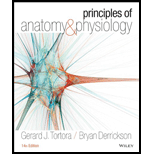
Concept explainers
To review:
The three main parts of a cell, following their functions.
Introduction:
The cells are considered as the basic functional and structural unit of an organism’s body. A cell is typically called as the building block of life, which aggregates to form tissue, organ, and organ system.
Explanation of Solution
The three different parts of the cell are mentioned below:
1. Plasma membrane: The outer surface that separates the internal and the external environment of a cell is called as plasma membrane or cell membrane. It is composed of a lipid bilayer, which is selectively permeable. It works as the barrier, in order to control influx and efflux of the molecules or ions across the cell.
2. Nucleus: It is the most important part of the cell. It consists of the hereditary information of the cell in the form of DNA. Furthermore, it controls all the activities of the cell, like growth, intermediary
3. Cytoplasm: The cytoplasm is the fluid present between the nucleus and the cell membrane. It comprises various organelles like ribosomes, mitochondria, centrioles, endoplasmic reticulum, lysosomes, and so on. It is the center for most of the cellular activities like protein synthesis, photosynthesis (in plants), and
Thus, the three main parts of the cell are nucleus, plasma membrane, and cytoplasm. Plasma membrane acts as the barrier between the cellular external and internal environment and allow selected molecules to cross through it. Nucleus control all the cellular activities as it contain the hereditary material i.e. DNA. Cytoplasm consist several organelles and acts as the center for most of the cellular activities.
Want to see more full solutions like this?
Chapter 3 Solutions
Principles of Anatomy and Physiology
- Noggin mutation: The mouse, one of the phenotypic consequences of Noggin mutationis mispatterning of the spinal cord, in the posterior region of the mouse embryo, suchthat in the hindlimb region the more ventral fates are lost, and the dorsal Pax3 domain isexpanded. (this experiment is not in the lectures).a. Hypothesis for why: What would be your hypothesis for why the ventral fatesare lost and dorsal fates expanded? Include in your answer the words notochord,BMP, SHH and either (or both of) surface ectoderm or lateral plate mesodermarrow_forwardNot part of a graded assignment, from a past midtermarrow_forwardNot part of a graded assignment, from a past midtermarrow_forward
- please helparrow_forwardWhat does the heavy dark line along collecting duct tell us about water reabsorption in this individual at this time? What does the heavy dark line along collecting duct tell us about ADH secretion in this individual at this time?arrow_forwardBiology grade 10 study guidearrow_forward
 Human Biology (MindTap Course List)BiologyISBN:9781305112100Author:Cecie Starr, Beverly McMillanPublisher:Cengage Learning
Human Biology (MindTap Course List)BiologyISBN:9781305112100Author:Cecie Starr, Beverly McMillanPublisher:Cengage Learning Human Physiology: From Cells to Systems (MindTap ...BiologyISBN:9781285866932Author:Lauralee SherwoodPublisher:Cengage Learning
Human Physiology: From Cells to Systems (MindTap ...BiologyISBN:9781285866932Author:Lauralee SherwoodPublisher:Cengage Learning





